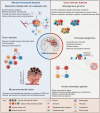Cancer cell heterogeneity and plasticity: A paradigm shift in glioblastoma
- PMID: 34932099
- PMCID: PMC9071273
- DOI: 10.1093/neuonc/noab269
Cancer cell heterogeneity and plasticity: A paradigm shift in glioblastoma
Erratum in
-
Erratum to: Cancer cell heterogeneity and plasticity: A paradigm shift in glioblastoma.Neuro Oncol. 2022 Nov 2;24(11):2011. doi: 10.1093/neuonc/noac134. Neuro Oncol. 2022. PMID: 35640268 Free PMC article. No abstract available.
Abstract
Phenotypic plasticity has emerged as a major contributor to intra-tumoral heterogeneity and treatment resistance in cancer. Increasing evidence shows that glioblastoma (GBM) cells display prominent intrinsic plasticity and reversibly adapt to dynamic microenvironmental conditions. Limited genetic evolution at recurrence further suggests that resistance mechanisms also largely operate at the phenotypic level. Here we review recent literature underpinning the role of GBM plasticity in creating gradients of heterogeneous cells including those that carry cancer stem cell (CSC) properties. A historical perspective from the hierarchical to the nonhierarchical concept of CSCs towards the recent appreciation of GBM plasticity is provided. Cellular states interact dynamically with each other and with the surrounding brain to shape a flexible tumor ecosystem, which enables swift adaptation to external pressure including treatment. We present the key components regulating intra-tumoral phenotypic heterogeneity and the equilibrium of phenotypic states, including genetic, epigenetic, and microenvironmental factors. We further discuss plasticity in the context of intrinsic tumor resistance, where a variable balance between preexisting resistant cells and adaptive persisters leads to reversible adaptation upon treatment. Innovative efforts targeting regulators of plasticity and mechanisms of state transitions towards treatment-resistant states are needed to restrict the adaptive capacities of GBM.
Keywords: glioblastoma; plasticity; treatment resistance; tumor heterogeneity; tumor microenvironment.
© The Author(s) 2021. Published by Oxford University Press on behalf of the Society for Neuro-Oncology.
Figures



References
-
- Turajlic S, Sottoriva A, Graham T, Swanton C. Resolving genetic heterogeneity in cancer. Nat Rev Genet. 2019; 20(7):404–416. - PubMed
Publication types
MeSH terms
LinkOut - more resources
Full Text Sources
Other Literature Sources
Medical

